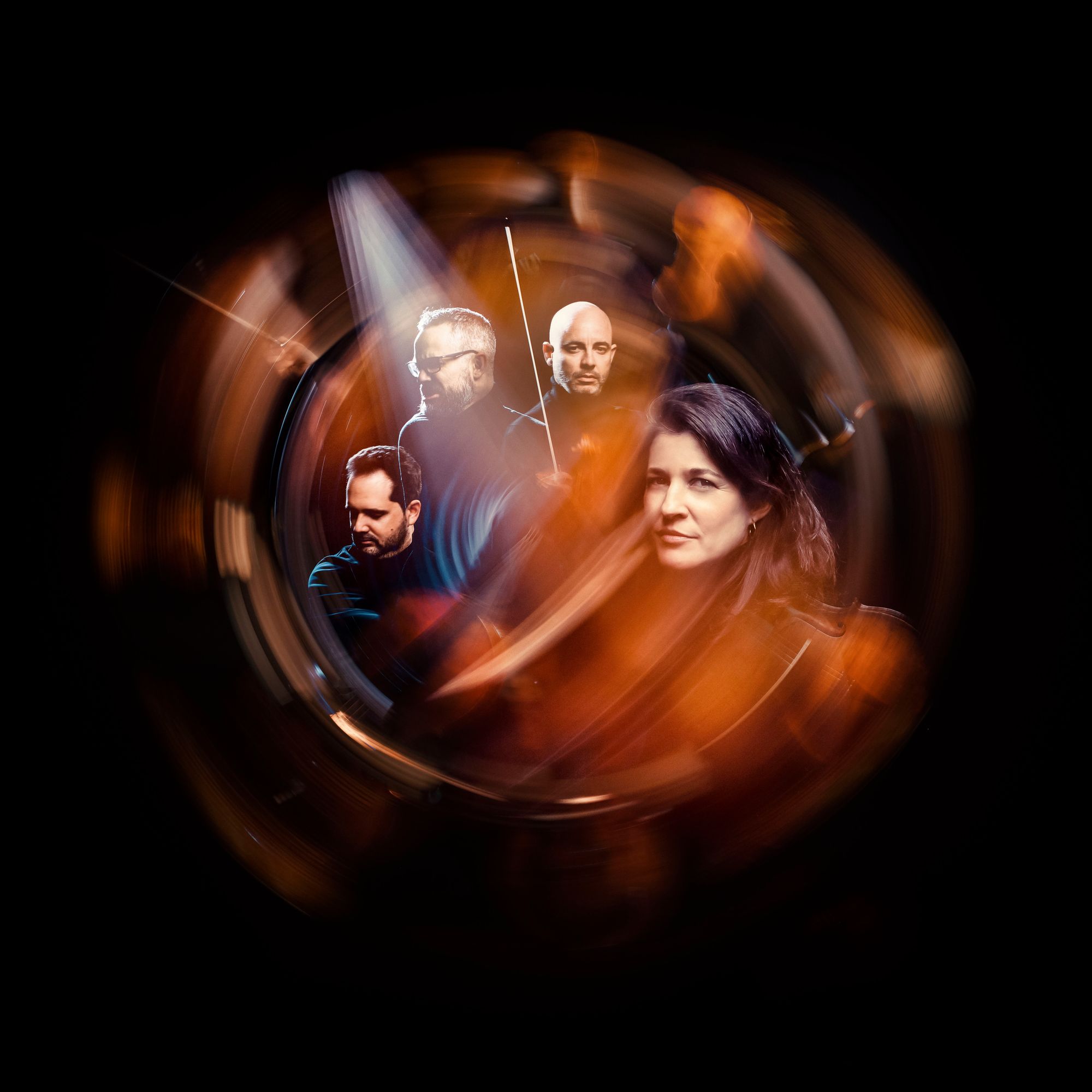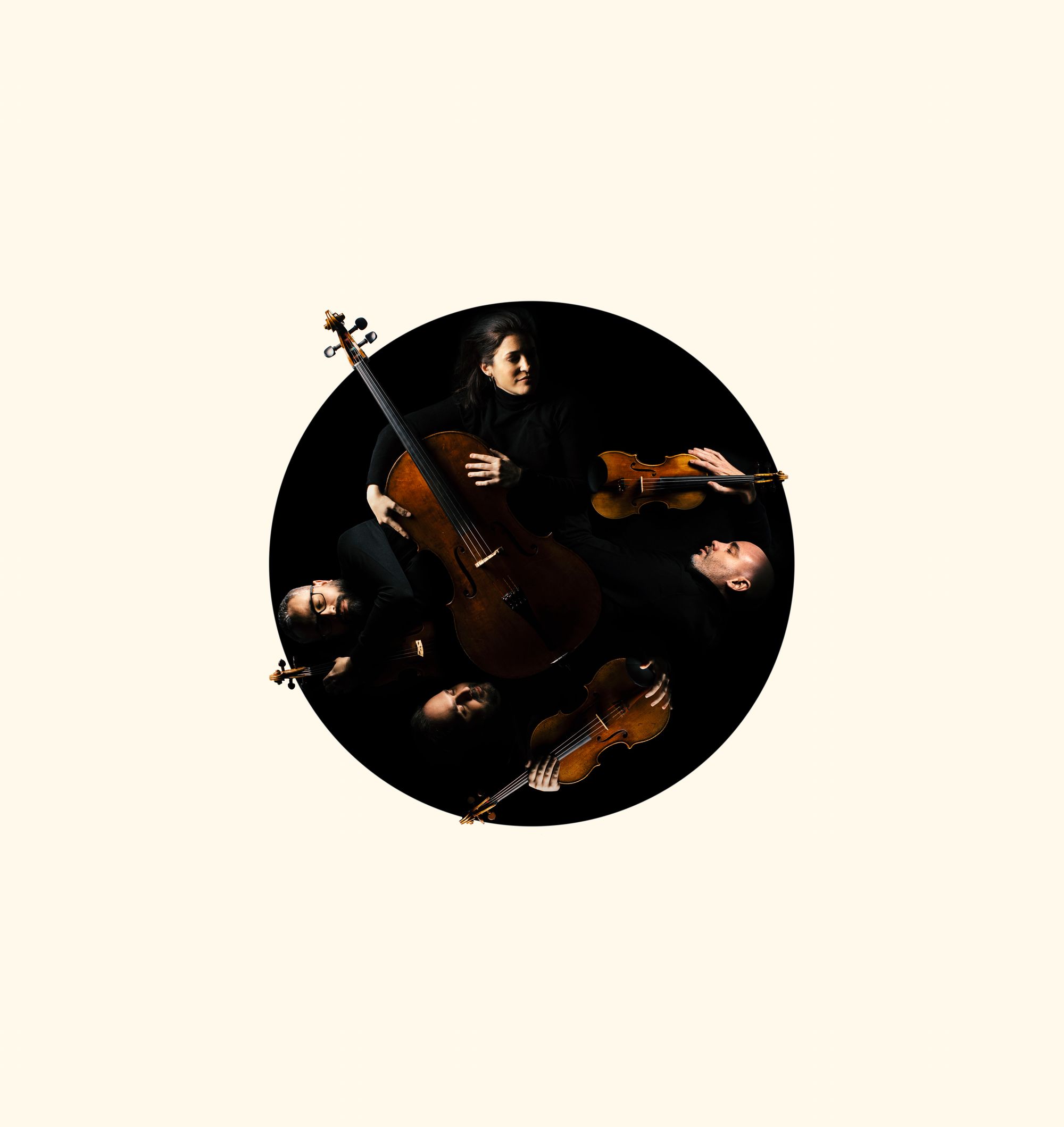ATOMOΣ: Cuarteto Quiroga, the Art of Musical Concentration
A quite remarkable album, one that requires the utmost attention from the listener, and offers rewards accordingly

To celebrate their 20th anniversary, Cuarteto Quiroga has released an eighth album, on Cobra Records - it includes the World Premiere or György Kurtág’s Secreta.
Laureates of Spain's National Music Award 2018, the Spanish National Music Award and laureates of a tramche of international competitions, Cuarteto Quiroga became, in 2013, the first ensemble-in-residence at the Royal Palace of Madid. Currently a resident ensemble at Madrid’s Cerralbo Museum, the quartet believes contemporary music is vital and has premiered music by composers such as Peter Eötvös. Cristóbal Halffter and Cecilia Díaz, as well as performing Kurtág’s complete corpus for theie mediu. The Quartet’s association with the Dutch label Cobra Records dates back to 2012. A previous album, Und es ward Licht was released in 2021, subtitled “The Birth of a New Era, in C Major,” featired Veronika Hagen (of the Hagen String Quartet); another disc, Heritage, is an overview of the Madrid string quartet scene in Goya’s time. The quartet is named after the Galician violinist Manuel Quiroga. They studied with Walter Levin at the Musikakademie in Basel, and at the Escuela Superior de Müsica Reina Sofia at the European Academy of Chamber Music. They have studied with great Hungarian masters such as András Keller (see tomorrow’s post about the Concerto Budapest Symphony Orchestra). Ferenc Rados (who was featured in this Classical Explorer post) and Kurtág himself.

The title, Atomos (ἄτομος) is Greek and refers to the art of musical concentration (‘A-tomos’ means indivisible) - musical ideas honed to their most concise forms, a precept that could apply to just about all of Kurtág’s music. The second violinist of Cuarteto Quiroga, Cibrán Sierra Vázque, explains:
Think of the restraint required to communicate with such brevity. In a world that reserves praise for the monumental, the sumptuous, the gargantuan, the opulent, the colossal, qualities of simplicity, moderation, austerity and subtlety seem in greater need of upholding. We are thrilled to be taking the listener on a journey through the development of the string quartet from Haydn, who defined and canonized the form, to Beethoven who took the form to its zenith creating an arch to the 20th century of Webern and Bartók. Kurtág, now 96, has long championed the art of musical brevity with greater authenticity, courage, boldness and poignant poetic beauty than any other living composer. We are thrilled to connect that world premiere recording with a rarity of the father of string quartet, Joseph Haydn, whose brief Op.42 which was most likely commissioned for Spain,where Haydn’s music enjoyed huge popularity and specifically for José Álvarez de Toledo, Marquis of Villafranca.
The booklet explains further: “Thsi album aims to illustrate how certain composers’ search for the nucleus of musical expression, their desire to compress sound to a particle incapable of further division, in other words to its atom, has resulted in some of the mist striking musical achievements in what is in any case an exceptional repertoire”.
It all begins, as so often, with Haydn, and probably the shortest of that compsoer’s 68 quartets, the D-Minor, Op. 42 (1780, Hob. III:43). The slow movement, marked “Adagio e cantabile,” encapsulates this concentration of expression beautifully:
... while the finale, a Presto, blazes with energy, its pithy argument dancing infectiously:
Classical Explorer has considered a number of Haydn Quartet discs in the past: the Charoscuro on BIS here (Op. 76, Nos. 1-3) and here (Op. 76, Nos. 4-6); the Quatuor Psophos in Op. 54 here, and the American Art Quartet, a historical recording, in the so-called “Lark” Quartet here.
Beethoven’s “Serioso” Quartet (F-Minor, Op. 95, 1810) maximally contrasts with the length of the so-called “Razumovsky” Quartets. It is interesting that in bringing this focus on brevity, and with it ths heer importance of each gesture, the Quiroga Quartet creates equivalences with the Haydn in terms of the sense of a conversation - of the exchange of ideas between instruemnts, or groups (pairs) of instruments. One can hear this well in the super-charged first movement. Listen also to the sheer definition of the cello (Helena Poggio) at speed, or how Aitoe Hevia’s first violin can blossom out into lyricism at a second’s notice:
To attain this level of concentration, performances have to be - and are - of the highest possible level. That pertains to the more lyrical secions, too. With the second moveent, we are a hair’s breadth away from the Elysian fields of the late-period quartets (remember, we covered the A-Minor Quartet, Op. 132 in this post):
It beomes increasingly apparent as one listens that this concentration of expression can move in two ways: blaxing fire or searing interiority. Here’s the former, the Scherzo of Op. 95 (the quartet as a whole gets its nickname from this movement’s tempo indication, “Allegro assai vivace ma serioso”):
The finale begins with a Larghetto espressivo which has arely morphed as smoothly or as convncingly into the Allegretto agitato main body as here:
The Quiroga’ß principal achievement here tis to convey the exploratory nature of Beethoven’s thought so well. One can easily pointto the spectacular technical prowess of the coda, but it is the sheer musical achievement here that is so impressive.
This is Op. 95’s first appearance on Classical Explorer in its pure form: we covered the Mahler arrangement for string orchestra when it was performed at the Sheffield Chamber Music Festival last year.

It is so good to have a reminder of the excellence, and import, of Bartók’s String Quartets. That reminder comes in the shape of the Third Quartet of 1927, Sz 85 / BB 93. It begins so quietly you might need to turn your volume dial to the right (or equivalent slider thingy if listening digitally); but soon its struts proudly, and loudly. A mere 16 minutes, the Third Quartet is the very definition of concision of thought, with the opening of the first movement containing in microcosm so much of what is to follow:
Out of this come wild dances, ferocious climaxes and whole new worlds. Try the “Seconda parte,” where Night Music meets peasant dance:
Surely the most affecting part of this performance is the third section, “Ricapitulazione della prima parte”; so much more than a recap, it seems to take that first part.for a walk, as if the music is forever altered after the “Seconda parte”:
The coda begins with an insectile buzzing before progressing to music of intense power, the spirit ofthe dance underlying it all:
There are a lot of convincing performances of the Bartók String Quartets, but this is, I believe, the finest of the Third I have heard (including historical performances). It would be the ideal “in” for Bartók-deniers!.
The Hungarian aspect of the disc continues with music by Kurtág. Only recently, the Proms presented that nonagenarian composer’s opera, at least as it currently stands Endgame (review). Here, we have Secreta: Funeral Music im memoriam László Dobszay in its World Premiere recording. In her booklet notes, Cibrán Sierra Vázquez puts it beautifully:
... an epitaph whose unnerving allure compels is to confront the void, where atoms merge with dark matter and sound seems to disintegrate within a black hole of silence
Hear Kurtág’s extraordinary, whisprered world for yourself:
The disc ends with a ‘bonus track’ by that Master of musical distillation, Anton von Weberm his fifth Bagatelle from the Op 9 set of Bagatelles (1911/13). How perfectly this complements the Kurtág:
A quite remarkable album, one that requires the utmost attention from the listener, and offers rewards accordingly. As a post-bonus, here is a programme the Quiroga Quartet devised, explicitly called “The Quartet as Conversation (1780-1800),” comprising works by Haydn (Op. 35/5), Ignaz Pleyel (Op. 1/4) and Mozart (K 421):
In January 2024, the Quarteto Quiroga will give the World Premiere of Jonathan Dove’s string quartet Togetherness in Holland; in amongst a raft of other premieres is the Swiss and Spanish premieres of Jörg Widmann”s Ninth String Quartet in Bern and Madrid, respectively. New commissions from composers Konstantia Gourzi and Raquel Garcia Tomás initiate a project celebrating the quartet's 20th anniversary: a project to promote the works of female composers via annual commissions.
The Spotify link to this album is here. All photos ©Igor Studio.
